What Health Issues Are Common in British Shorthair Cats?
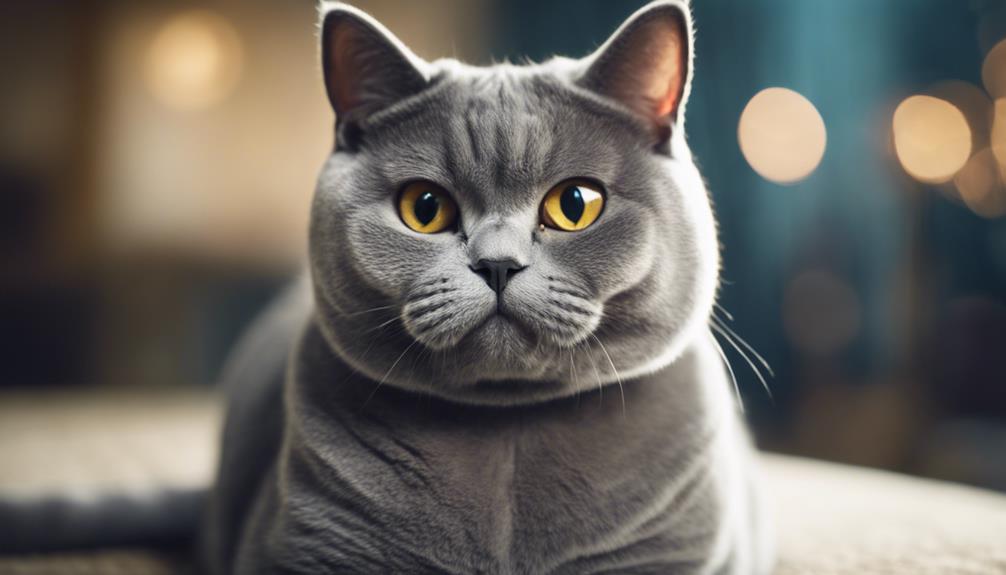
Common Health Issues in British Shorthair Cats:
Genetic heart conditions and urinary tract complications are among the top concerns for these beloved felines. Owners should be proactive in understanding and addressing these issues to ensure their cats' well-being.
Genetic Heart Conditions
Genetic heart conditions, such as Hypertrophic Cardiomyopathy (HCM), pose a significant health concern for British Shorthair cats due to the thickening of their heart muscles. These felines have a genetic predisposition to develop HCM, making them more susceptible compared to other breeds. The condition can lead to serious complications like blood clots or heart failure, affecting the cat's overall well-being. Therefore, regular vet checkups are essential for British Shorthair cats to monitor their heart health closely.
Early detection of HCM through routine veterinary visits is crucial for timely intervention and management. Veterinarians can recommend suitable treatment plans that may involve medications to prevent clots and regulate the cat's heart rate. By addressing the thickening of the heart muscles promptly, the quality of life for British Shorthairs with HCM can be significantly improved. Owners of British Shorthair cats should prioritize regular checkups to ensure any potential heart issues are detected and managed effectively.
Hemophilia in British Shorthairs
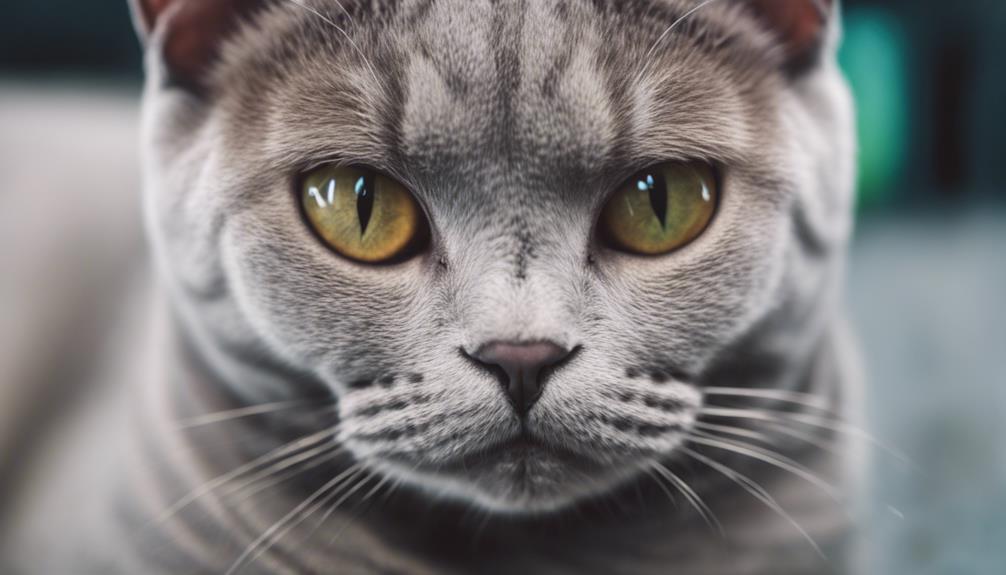
Discussing the hereditary bleeding disorder known as hemophilia in British Shorthairs sheds light on the challenges these cats face in managing excessive bleeding episodes. Hemophilia in British Shorthairs is characterized by a deficiency in factor IX, a crucial clotting protein. This deficiency puts affected cats at risk of prolonged and excessive bleeding, even from minor injuries or routine surgeries.
While there's no cure for hemophilia in British Shorthairs, certain precautions can be taken to reduce the risk of bleeding episodes. Keeping these cats indoors can help prevent accidents that may lead to injuries requiring medical attention. Regular monitoring and quick veterinary intervention are essential to effectively manage bleeding episodes in British Shorthairs with hemophilia.
The condition can significantly impact the quality of life for these cats, underscoring the importance of preventive measures and consistent veterinary care to ensure their well-being and manage the challenges associated with this inherited bleeding disorder.
Kidney Health Concerns
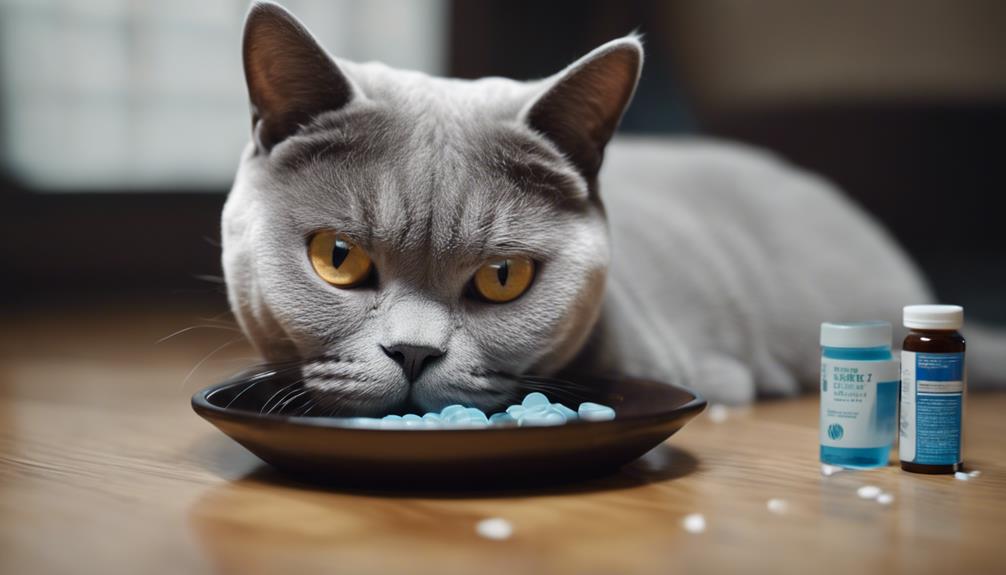
Kidney health concerns are prevalent among British Shorthair cats, with Polycystic Kidney Disease (PKD) being a common genetic condition leading to the growth of cysts in the kidneys. PKD can exhibit symptoms such as increased drinking and urination, weight loss, and a decline in kidney function.
Diagnosis of PKD in British Shorthairs involves genetic testing and ultrasound examinations. Management of this condition focuses on supporting kidney function and providing symptomatic relief for affected cats. Regular monitoring and early intervention play vital roles in effectively managing PKD in British Shorthairs.
Infectious Diseases to Watch For
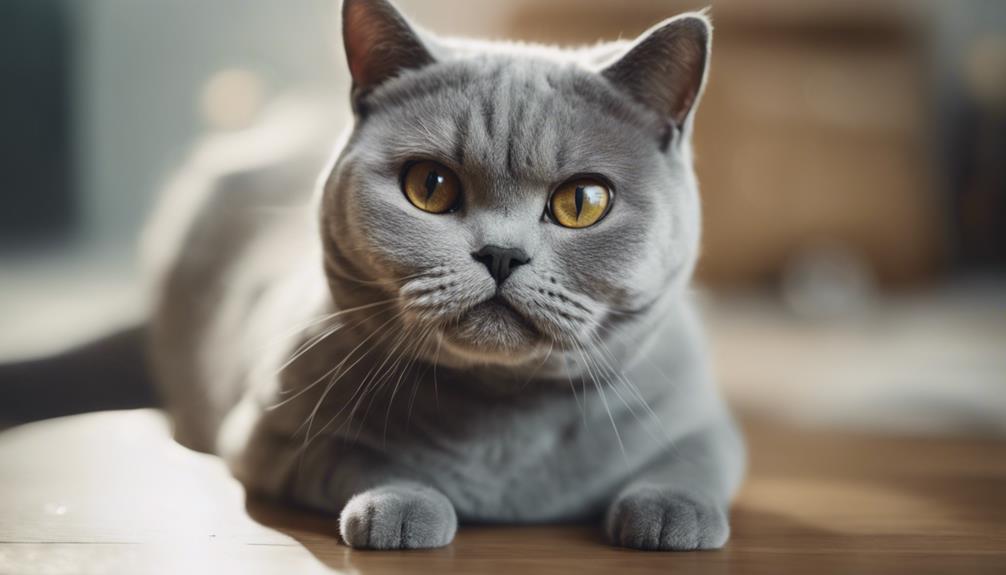
When caring for British Shorthair cats, vigilance against infectious diseases is paramount to ensure their well-being and longevity. These beloved felines are particularly susceptible to certain health issues, such as Feline Infectious Peritonitis, which is caused by coronavirus mutations. Signs of this fatal condition include fever and weight loss, necessitating immediate veterinary attention.
British Shorthairs with heart disease are at risk of developing Feline Aortic Thromboembolism, a condition that can lead to hind leg pain and paralysis. However, early detection and proper medication can help prevent blood clots in these cats with heart disease, ensuring a better quality of life.
- Feline Infectious Peritonitis caused by coronavirus mutations poses a greater risk to British Shorthairs.
- Cats with heart disease may develop Feline Aortic Thromboembolism, leading to hind leg issues.
- Early detection and appropriate treatment are crucial for managing infectious diseases in British Shorthair cats.
Urinary Tract Complications
British Shorthair cats are particularly prone to urinary tract complications, including conditions like Feline Lower Urinary Tract Diseases (FLUTD) and Polycystic Kidney Disease (PKD).
FLUTD in British Shorthairs can encompass issues such as infections, stones, and blockages, leading to symptoms like blood in the urine and difficulty urinating, indicating potential urinary problems.
PKD, another common concern, involves the development of cysts in the kidney tissue. Signs of urinary tract issues in British Shorthairs may include increased drinking and urination, highlighting the need for prompt veterinary evaluation and care.
Monitoring their urinary habits and seeking early intervention for urinary tract problems are crucial in maintaining the health and well-being of British Shorthair cats.
Owners should be vigilant for any changes in their cat's urination patterns or any signs of discomfort, as proactive management can help mitigate the risks associated with FLUTD and polycystic kidney disease in these feline companions.
Blood Clotting Disorders

British Shorthair cats are at risk of developing blood clotting disorders, particularly in association with heart conditions like hypertrophic cardiomyopathy. These disorders can lead to arterial thromboembolism, causing severe blockages that result in sudden paralysis and hind leg weakness.
Understanding the risk factors, recognizing symptoms, and knowing treatment options are crucial in managing blood clotting disorders in British Shorthairs.
Risk Factors Identified
With a predisposition to heart disease, particularly hypertrophic cardiomyopathy (HCM), British Shorthair cats face an elevated risk of developing blood clotting disorders.
- Overactive thyroid glands in British Shorthairs can lead to thickened heart muscles, increasing the likelihood of blood clots.
- Arterial thromboembolism, such as FATE in cats with heart disease, poses a severe threat as blood clots can block arteries and hinder blood flow, especially to the hind legs.
- Genetics play a role in the increased susceptibility of British Shorthairs to blood clotting disorders linked to heart conditions.
Understanding these risk factors is crucial for early detection and prevention of blood clotting disorders in British Shorthair cats, emphasizing the importance of regular veterinary check-ups and proactive heart health management.
Symptoms and Signs
Blood clotting disorders in cats, particularly those with heart disease like hypertrophic cardiomyopathy (HCM), can manifest through specific symptoms and signs. Cats with HCM are at risk of developing arterial thromboembolism, which can result in feline aortic thromboembolisms (FATE), leading to hind leg paralysis and pain. Symptoms of arterial thromboembolism include sudden hind leg weakness, coldness, and pain in the affected limbs.
Immediate medical attention is crucial for cats suspected of having blood clot issues, as this condition can be life-threatening. Treatment for arterial thromboembolism focuses on clot dissolution and managing pain to restore blood flow and function. If a feline shows any of these symptoms, prompt veterinary evaluation is essential.
Treatment Options Available
When addressing clotting disorders in cats, treatment options typically involve medications to dissolve clots and prevent their formation. British Shorthair cats with blood clotting disorders, such as FATE, require immediate medical attention to avoid life-threatening consequences. Pain management is crucial for the comfort of cats dealing with these disorders. Clot dissolution therapy is a primary focus in treating clotting disorders, especially in cats with heart disease. Regular monitoring and follow-up care play a vital role in managing blood clotting disorders in British Shorthairs to prevent recurrence.
Immediate medical attention is crucial for cats with blood clotting disorders like FATE.
Pain management is essential for the comfort of cats with clotting disorders.
Regular monitoring and follow-up care are vital in managing blood clotting disorders in British Shorthair cats.
Diaphragmatic Hernias
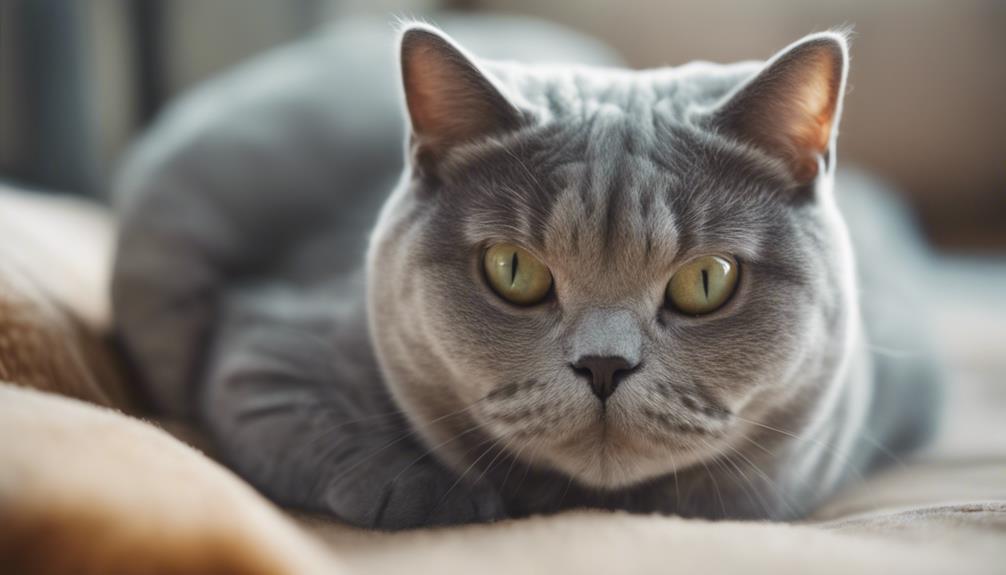
Diaphragmatic hernias in British Shorthair cats are often congenital, leading to abnormal openings in the diaphragm. This condition can result in serious complications like vomiting and respiratory distress.
Treatment usually involves surgical correction to address the hernia and alleviate associated symptoms.
Causes of Hernias
A common cause of hernias in British Shorthair cats is a congenital defect known as Peritoneopericardial Diaphragmatic Hernia (PPDH). This defect affects the communication between the pericardium and peritoneum, leading to potential complications.
Here are some key points regarding the causes of hernias in British Shorthair cats:
- PPDH is a congenital defect that disrupts the normal connection between the pericardium and peritoneum.
- The herniation caused by PPDH can result in serious issues like vomiting and breathing difficulties.
- Surgical intervention is often necessary to correct the hernia and prevent further complications in affected British Shorthair cats.
Symptoms to Watch
Early signs of a diaphragmatic hernia in British Shorthair cats may include subtle changes in their breathing patterns and increased restlessness. As the condition progresses, symptoms such as vomiting, difficulty breathing, abnormal chest movements, and respiratory distress can become more apparent. Since diaphragmatic hernias can lead to serious complications like heart disease and blood clots, it is crucial to monitor your cat for any signs of distress. Diagnostic tools like X-rays and ultrasounds are commonly used to confirm the presence of a diaphragmatic hernia. Prompt surgical intervention is often necessary to repair the hernia and alleviate symptoms, ensuring the well-being of the affected British Shorthair cat.
| Symptoms to Watch | Description | Importance |
|---|---|---|
| Breathing Pattern Changes | Subtle alterations in breathing may indicate a diaphragmatic hernia. | Early Detection is Key |
| Increased Restlessness | Restlessness can be a sign of discomfort due to the hernia. | Indicates Discomfort |
| Vomiting | Diaphragmatic hernias may lead to vomiting, especially after meals. | Watch for Digestive Issues |
Treatment Options Available
As veterinarians address Peritoneopericardial Diaphragmatic Hernias in British Shorthair cats, treatment options encompass surgical intervention as a primary approach to rectify the congenital defect. Surgery for Peritoneopericardial Diaphragmatic Hernia in British Shorthairs offers a significant chance to improve their quality of life. The procedure aims to correct the communication issue between the pericardium and peritoneum, alleviating symptoms like vomiting and breathing difficulties.
Besides surgery, post-operative care and regular monitoring play crucial roles in ensuring the cat's well-being and preventing complications. Veterinary attention must be prompt upon noticing any signs of Peritoneopericardial Diaphragmatic Hernia, as early diagnosis enhances the success of surgical treatment.
- Surgical intervention is the primary treatment for Peritoneopericardial Diaphragmatic Hernia.
- Post-operative care and regular monitoring are essential for the cat's recovery.
- Prompt veterinary attention is crucial to address the issue early and improve the cat's quality of life.
Frequently Asked Questions
Do British Shorthairs Have Lots of Health Problems?
British Shorthairs are genetically predisposed to common ailments like heart disease and kidney issues. Regular vet check-ups, preventive care, and a balanced diet are essential. Allergies, cataracts, and sensitivities can also impact their health, warranting close attention.
What Is the Life Expectancy of a British Shorthair Cat?
British Shorthair cats typically live 12 to 20 years. To enhance longevity, owners should focus on proper diet, regular exercise, preventive healthcare, monitoring for common illnesses, addressing genetic predispositions, and ensuring a high quality of life.
What Are the Negative Traits of British Shorthair Cats?
British Shorthair cats may display aloofness, independence, and a preference for personal space. They can be slow to warm up to new people or changes. Training might pose challenges due to their stubborn streak.
What Is the Disease in British Shorthair Cats?
British Shorthair cats commonly face respiratory issues, kidney disease, skin conditions, digestive problems, heart conditions, and joint pain. It's crucial for owners to monitor these health concerns and seek veterinary care promptly for optimal feline well-being.











